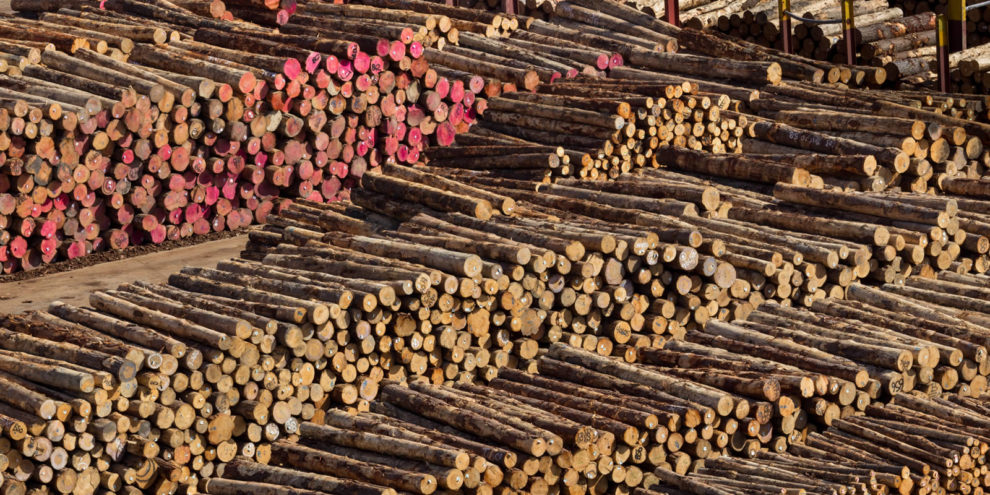Each week, as part of our research for the Forisk Market Bulletin and Wood Fiber Review, our team communicates with dozens of forest industry professionals and investors. These discussions typically focus on specific timberland transactions or mill investments and technologies, but at times they go broader to reveal patterns or concerns common across sectors and regions. Recently, two themes emerged: lumber prices and forest management.
High Lumber Prices and Unresponsive Timber Prices
With softwood lumber prices setting records, why haven’t timber (log) prices increased? This story has (at least) two parts. First, the relationship between softwood lumber prices and softwood stumpage prices, in the South in particular, is tenuous at best. Historically, lumber and log prices rarely correlate strongly or in lockstep. Prior to the Great Recession of 2007-2009, Forisk’s research and original price forecast models found a positive, modest correlation of 0.2 to 0.4 between pine sawtimber stumpage and softwood lumber prices with a lag of 6 to 15 months. This relationship varied across states and local timber markets, and over time.
After the Recession, this relationship disintegrated. To quote Forisk research from 2012: States with the most severe pine grade “oversupplies” showed material decreases in their price-to-demand relationships over the past five years…In sum, elasticities have fallen and [pine grade stumpage] prices remained suppressed even as lumber prices skyrocketed for most states.
So, yes, we’ve seen this situation before.
Second, the current situation speaks more to supply chain issues than to high levels of demand. Climbing lumber prices reflect a confluence of short-term factors. Strong reductions in production and capacity earlier in 2020 corresponded with real-time demand growth from COVID-confined families dusting off their at-home DIY projects. This depleted softwood lumber inventories as housing starts accelerated again. Meanwhile, lumber manufacturers, doing their best to manage safe operations and coronavirus quarantines, are mixing and matching personnel from three shifts to get two shifts of production.
And consider the context. We’re still on pace to build fewer homes and consume less lumber in 2020 than we did in 2019 in the U.S. So, it’s not like we blew the top off the volcano. Rather, someone pinched the hose.
Should We Keep Our Forests? And Should We Manage Them?
We talk with forestry consultants and brokers we indicate these questions now come up more frequently, especially in areas with low timber prices and high forest supplies. What arguments can be made to convince landowners to keep their timberlands and invest in forest management?
For me, this question comes down to available alternatives and investment objectives. When speaking with landowners who talk about selling their timberlands, assets that may have been in the family for decades, I often ask “what are you going to do with the money? What alternative investments do you have lined up?”
My experience to date has been that “investment-oriented” forest owners and their heirs do not have great alternatives that (1) consistently generate cash and (2) preserve wealth/diversify with a hard asset (and (3) offer hunting and other recreation). While everyone wants higher timber prices and more cash, in the context of an uncertain world, the wealth preservation, cash generation, security and enjoyment of owning a forest is a “package” of benefits difficult to replace.
As for forest management, even in places with high forest supplies, the long-term dynamics justify active forest management if a primary objective is to maximize financial returns. We see this in our current research with timberland owners and managers in the U.S. South and Pacific Northwest.
On the other hand, if heirs need the money or have other opportunities or objectives, I do my best to direct them towards potential buyers who would or could appreciate the forest and forestry-related benefits and continue to manage the assets as forests.
This content may not be used or reproduced in any manner whatsoever, in part or in whole, without written permission of LANDTHINK. Use of this content without permission is a violation of federal copyright law. The articles, posts, comments, opinions and information provided by LANDTHINK are for informational and research purposes only and DOES NOT substitute or coincide with the advice of an attorney, accountant, real estate broker or any other licensed real estate professional. LANDTHINK strongly advises visitors and readers to seek their own professional guidance and advice related to buying, investing in or selling real estate.










Excellent summary of where the timber land/stumpage supply prices are low while the lumber prices are soaring.
I would really like to know per acre what is a fair price for timber in Brunswick County, Virginia. There is too much double talk.
Timber stands are not homogeneous from tract to tract. It just depends on what species you have, the size of the trees, density of the trees, access and operability through different weather conditions, and proximity to mills for the forest products on your property. What you may consider double talk may be a lack of understanding of these factors. If you want to be sure that you’re getting a fair price then get multiple lump sum offers for a timber sale with clear parameters on what cuts and what doesn’t with set date for opening sealed bids and clearly defined contract term to harvest the timber.